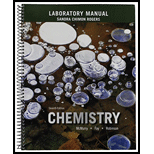
Concept explainers
To determine:
The electron configuration of
Concept introduction:
- Electronic configuration of an atom shows how electrons are placed in the orbitals in order of increasing energy.
- The filling of the sublevels progresses in order up to Period 4. However, in the sublevel blocks in Period 4 the 4s sublevel fills before the 3dsublevel.This occurs because the electrons in the 4ssublevel have slightly lower energy than the electrons in the 3d sublevel. This series of 10 elements is called the first transition series (3d).
- 3d elements show large variation in their oxidation states.
Answer to Problem 20.1P
Solution:
:
Explanation of Solution
The arrangement of atomic orbitals in increasing order of their energies is as follows:
The maximum occupancy of electrons for
Thus, electronic configuration will be:
Now, electrons are first removed from
Thus, the electronic configuration of
(c)
To determine:
The electron configuration of metal in
Concept introduction:
- Electronic configuration of an atom shows how electrons are placed in the orbitals in order of increasing energy.
- The filling of the sublevels progresses in order up to Period 4. However, in the sublevel blocks in Period 4 the 4s sublevel fills before the 3dsublevel.This occurs because the electrons in the 4ssublevel have slightly lower energy than the electrons in the 3d sublevel. This series of 10 elements is called the first transition series (3d).
- 3d elements show large variation in their oxidation states.
Answer to Problem 20.1P
Solution:
:
Explanation of Solution
Atomic number of manganese is 25. Thus, it has 25 electrons in its elemental state. The arrangement of atomic orbitals in increasing order of their energies is as follows:
The electronic configuration will be:
Oxygen has an oxidation state of -2, thus in
(d)
To determine:
The electron configuration of metal in
Concept introduction:
- Electronic configuration of an atom shows how electrons are placed in the orbitals in order of increasing energy.
- The filling of the sublevels progresses in order up to Period 4. However, in the sublevel blocks in Period 4 the 4s sublevel fills before the 3dsublevel.This occurs because the electrons in the 4ssublevel have slightly lower energy than the electrons in the 3d sublevel. This series of 10 elements is called the first transition series (3d).
- 3d elements show large variation in their oxidation states.
Answer to Problem 20.1P
Solution:
Explanation of Solution
Atomic number of copper is 29. Thus, it has 29 electrons in its elemental state. The arrangement of atomic orbitals in increasing order of their energies is as follows:
The maximum occupancy of electrons for
Thus, the electronic configuration will be:
This is because half filled, and full filled orbitals are more stable.
Chlorine has an oxidation state of -1, thus in
Now filling up 27 electrons of
to get its electronic configuration:
Want to see more full solutions like this?
Chapter 20 Solutions
Laboratory Manual for Chemistry (7th Edition)
 ChemistryChemistryISBN:9781305957404Author:Steven S. Zumdahl, Susan A. Zumdahl, Donald J. DeCostePublisher:Cengage Learning
ChemistryChemistryISBN:9781305957404Author:Steven S. Zumdahl, Susan A. Zumdahl, Donald J. DeCostePublisher:Cengage Learning ChemistryChemistryISBN:9781259911156Author:Raymond Chang Dr., Jason Overby ProfessorPublisher:McGraw-Hill Education
ChemistryChemistryISBN:9781259911156Author:Raymond Chang Dr., Jason Overby ProfessorPublisher:McGraw-Hill Education Principles of Instrumental AnalysisChemistryISBN:9781305577213Author:Douglas A. Skoog, F. James Holler, Stanley R. CrouchPublisher:Cengage Learning
Principles of Instrumental AnalysisChemistryISBN:9781305577213Author:Douglas A. Skoog, F. James Holler, Stanley R. CrouchPublisher:Cengage Learning Organic ChemistryChemistryISBN:9780078021558Author:Janice Gorzynski Smith Dr.Publisher:McGraw-Hill Education
Organic ChemistryChemistryISBN:9780078021558Author:Janice Gorzynski Smith Dr.Publisher:McGraw-Hill Education Chemistry: Principles and ReactionsChemistryISBN:9781305079373Author:William L. Masterton, Cecile N. HurleyPublisher:Cengage Learning
Chemistry: Principles and ReactionsChemistryISBN:9781305079373Author:William L. Masterton, Cecile N. HurleyPublisher:Cengage Learning Elementary Principles of Chemical Processes, Bind...ChemistryISBN:9781118431221Author:Richard M. Felder, Ronald W. Rousseau, Lisa G. BullardPublisher:WILEY
Elementary Principles of Chemical Processes, Bind...ChemistryISBN:9781118431221Author:Richard M. Felder, Ronald W. Rousseau, Lisa G. BullardPublisher:WILEY





